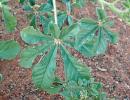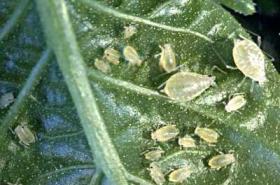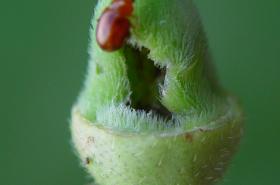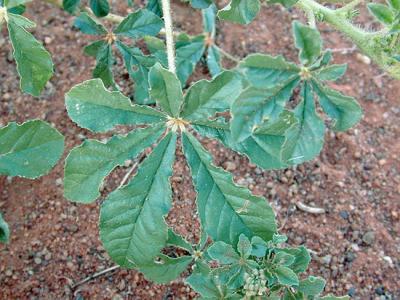
|
Spider plant
Scientific name:
Cleome gynandra
Order/Family:
Capparidales: Capparaceae
Local names:
Mwangani (Swahili), Thageti (Kikuyu), Tsisaka (Luhya), Alot-dek (Luo), Saget (Kalenjin), Chinsaga (Kisii), Mwianzo (Kamba), Jjobyu (Luganda), Yobyu (Lusoga)
Common names:
African cabbage, Spider flower, Spider wisp, Cat's whiskers
|
Aphids
Aphids can be serious pests during dry weather. Aphids are a major pest, causing leaves to curl and become unattractive to customers.
Aphids feed by sucking plant sap. Small aphid populations may be relatively harmless, but heavily infested plants usually have wrinkled leaves, stunted growth and deformed pods. Plants, particularly young plants, may dry out and die under heavy aphid attack. Heavy attack on older plants may cause crop loss by decreasing flower and capsule production. Damage may also reduce seed viability.
- Check the plants regularly. Aphids tend to be more common along upwind field borders and next to other leafy vegetable crops or weeds; so initial sampling should be focused in these areas. Because aphid populations are generally clumped within fields, each field should be uniformly sampled.
- Destroy aphids by rubbing them off, or by gently pressing the infested stems or leaves between your fingers. This helps controlling low, initial infestations.
- Apply a strong jet of water to dislodge aphids from attacked plants. When repeated at regular intervals, this method knocks aphid populations down to acceptable levels.
- Remove and destroy infested leaves. This helps reduce further infestations.
- Conserve natural enemies. Ladybird beetles, lacewings, hover fly larvae, parasitic wasps and naturally occurring aphid diseases are common and effective natural enemies of aphids.

© Magnus Gammelgaard
Beetles
Pure stands in Nairobi were observed to be attacked by flea beetles (Phyllotreta mashonana). (EcoPort: Wilfried Baudoin).
Flea beetles are tiny to small with enlarged hindlegs that enable them to jump long distance when disturbed. The adults vary in colour from shiny black or metallic grey to black with yellow stripes on the wing cases. Eggs are laid in the soil near the host plant. The larvae generally feed on the plant roots, but usually do not cause economic damage. The characteristic symptom of flea beetle attack is small, round holes all over the leaf surface. Damage may be of importance when flea beetles are present in large numbers, especially during the seedling stage.
- Weeding in and around fields may help to eliminate flea beetle shelters and breeding sites, reducing crop damage.
- Covering the seedbed with a fine-mesh material is useful to protect seedlings.

© A.M. Varela, icipe
| General Information and Agronomic Aspects | Information on Pests, Diseases and Weeds | |||
| Recipes | Information Source Links |
 |
| Geographical Distribution of Spider Plant in Africa |
Seeds can be extracted when the pods are fully ripe (yellow or black), but before they open naturally. Seeds should be kept in a dry, closed container for at least three months to reduce dormancy (ACRDC).
It requires a well-prepared seedbed without weeds and dug to a depth of about 15 cm followed by a light harrowing. It may be planted on traditional raised or flat beds. After digging, the soil is harrowed to a fine tilth. Organic manure is applied and worked into the soil. The seedbed is then levelled before planting. Plants can be grown on flat beds or on traditional raised beds, which are normally one m wide. The appropriate bed length depends on the amount of the crop to be grown, but may not exceed three m. There are usually narrow pathways between the beds to facilitate weeding and harvesting. These pathways also act as drainage channels during the very wet season, as plants do not withstand waterlogging. When raised beds are used, application of organic manure is delayed until the beds have been dug (Chweya and Mnzava,1997).
Shallow planting at one cm depth and with 30 cm between rows or broadcasting followed by raking on prepared seedbeds is recommended. Some farmers mix the seeds with sand when broadcasting them. About four g of seed per m2 or 40 kg per ha are required. Emergence is normally from 6 to 8 days after sowing. Thinning is done three weeks after emergence to leave 10 to 15 cm between plants (EcoPort).
Spider plant responds well to well-decomposed manure. Flowering is delayed when adequate manure is available, allowing more, larger leaves to be harvested. Optimum yields could be obtained with an application of 20 to 30 tons of manure per hectare. Topping and removing inflorescences as soon as they appear are other practices that increase leaf production for harvesting. This crop grows rapidly and requires weeding only in the open space between the rows. Plants require water two or three times a week. Periods of drought will hasten development of flowers and lower the yields. Pests and diseases are not usually serious and spraying with insecticides is not recommended even when aphids appear to become problematic. (AVRDC; Chweya and Mnzava, 1997)
- 1 kg spider plant leaves
- 1 medium onion
- 1/4 litre water
- 3 medium tomatoes
- 1 tsp salt
- 1/4 litre coconut milk
Harvest the young spider plant leaves including the stem tips then remove the leaf stalks. Wash the leaves with clean water and cut into small pieces. Place into a pot containing 1/4 litre of water, add 1 teaspoon of salt then vegetables and boil over a medium fire for 10 minutes. Next add 1/4 litre of dilute coconut milk and boil for 10 minutes. When leaves are cooked, mash in pot and add oil (or cow fat). Using a separate sufuria pot fry onions till brown, add tomatoes then vegetables and 1/4 litre of thick coconut milk (or fresh cow's milk), then cook for 5 minutes, stirring occasionally. the above provides 4 to 6 medium portions. It is best served with chapati, rice or ugali. To mix with other vegetables, boil Amaranth leaves and spider plant separately. When cooked, mix both then mash in one pot.
(FORMAT, http://www.formatkenya.org/ormbook/Chapters/chapter17.htm) (FORMAT, contributed by Maryam Imbumi).
- AVRDC Learning Center. Publication and Fact Sheets on Indigenous Vegetables: Spider plant. www.avrdc.org
- Chweya J.A. and Mnzava N.A. (1997). Cat's whiskers. Cleome gynandra L. Promoting the conservation of underutilized and neglected crops. 11. Gatersleben: IPK/Rome: IPGRI. ISBN 92-9043-303-5 www.bioversityinternational.org
- EcoPort: The consilience engine: www.ecoport.org page on spider plant
- FORMAT: Forum for Organic Resource Management and Agricultural Technologies. www.formatkenya.org
- Ouma, M.A. Indigenous vegetable production and utilization in Suba district, Kenya: Improving health, unlocking the wealth in Suba district. BioVision - T.T.U, ICIPE. Unpublished.
- SANBI: South African National Biodiversity Institute, South Africa. www.plantzafrica.com
- The Australian New Crops Newsletter, Issue No. 11, January 1999. www.newcrops.uq.edu.au
- Woomer, P. L. and Imbumi, M. (2003).Traditional Green Vegetables in Kenya. In Organic Resource Management in Kenya -Perspectives and Guidelines. Chapter 17. www.formatkenya.org Published by Forum for Organic Resource Management and Agricultural Technologies (FORMAT).

 Back
Back
